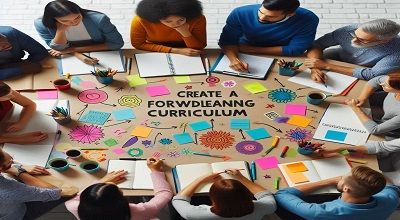A Forward-Leaning Curriculum
Creating a forward-leaning curriculum involves designing a learning plan that is dynamic, relevant, and adaptable to the rapidly changing needs of the learners and the world. Here are some steps and considerations to help you develop a forward-leaning curriculum:
Understand the Context:
- Identify the goals and objectives: Clearly define the purpose of your curriculum. What skills and knowledge do you want students to gain by the end of the program?
- Analyze the target audience: Understand the needs, backgrounds, and expectations of the learners.
Stay Informed about Trends:
- Monitor industry trends: Keep yourself updated on the latest developments in your field of study. This could involve regularly reading industry publications, attending conferences, or participating in professional networks.
- Follow educational trends: Be aware of innovations in teaching and learning methodologies. This includes understanding the use of technology, emerging pedagogies, and changes in educational paradigms.
Focus on Critical Skills:
- Identify essential skills: Determine the key skills that learners need to succeed in the current and future job market. This may include critical thinking, problem-solving, communication, and adaptability.
- Foster a growth mindset: Encourage learners to embrace challenges and see failures as opportunities to learn and improve.
Integrate Technology:
- Embrace digital tools: Integrate technology into your curriculum to enhance learning experiences. This could include online resources, virtual simulations, or collaborative platforms.
- Teach digital literacy: Equip students with the skills to navigate and critically evaluate information in the digital age.
Encourage Lifelong Learning:
- Foster a love of learning: Create a curriculum that sparks curiosity and encourages students to pursue knowledge beyond the classroom.
- Teach self-directed learning: Equip students with the skills to set goals, manage their time effectively, and take responsibility for their own learning.
Promote Interdisciplinary Learning:
- Break down silos: Encourage collaboration between different disciplines, fostering a holistic understanding of complex issues.
- Incorporate real-world applications: Connect theoretical knowledge to practical applications in various fields.
Adaptability and Flexibility:
- Build in flexibility: Design the curriculum to be adaptable to changes in technology, industry, and societal needs.
- Regularly review and update: Assess the curriculum periodically to ensure it remains relevant and effective.
Include Project-Based Learning:
- Engage in real-world projects: Incorporate hands-on, project-based learning experiences that mimic real-world scenarios.
- Encourage teamwork: Foster collaboration and communication skills through group projects.
Seek Feedback and Continuous Improvement:
- Regularly gather feedback: Collect input from students, industry professionals, and other stakeholders to understand the effectiveness of your curriculum.
- Iterate and improve: Use feedback to make continuous improvements, ensuring your curriculum stays current and meets the needs of learners.
Emphasize Cultural Competency:
- Foster diversity and inclusion: Design a curriculum that reflects diverse perspectives and experiences.
- Develop cultural competency: Ensure that students are equipped to navigate and appreciate diverse cultures and viewpoints.
By incorporating these principles into your curriculum design, you can create a forward-leaning educational experience that prepares students for the challenges and opportunities of the future. Keep in mind that adaptability and a willingness to evolve are essential components of a successful forward-leaning curriculum.
